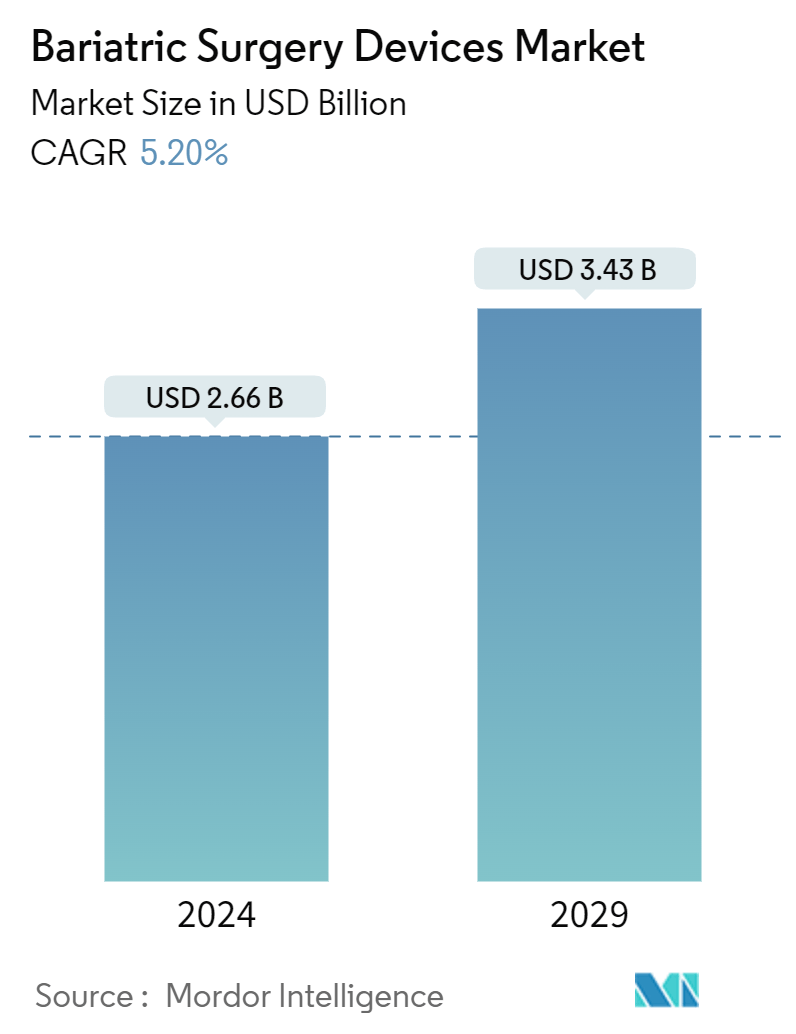Market Size of Bariatric Surgery Devices Industry

| Study Period | 2019 - 2029 |
| Market Size (2024) | USD 2.66 Billion |
| Market Size (2029) | USD 3.43 Billion |
| CAGR (2024 - 2029) | 5.20 % |
| Fastest Growing Market | Asia-Pacific |
| Largest Market | North America |
| Market Concentration | Medium |
Major Players
*Disclaimer: Major Players sorted in no particular order |
Bariatric Surgery Devices Market Analysis
The Bariatric Surgery Devices Market size is estimated at USD 2.66 billion in 2024, and is expected to reach USD 3.43 billion by 2029, growing at a CAGR of 5.20% during the forecast period (2024-2029).
- The bariatric surgery devices market is pivotal in combating the global obesity epidemic, which is closely linked to numerous health issues such as diabetes, heart disease, and hypertension. This market is divided into various device types, including assisting and implantable devices, catering to end-users like bariatric surgery clinics, hospitals, and ambulatory surgical centers across major regions. The growing demand for these devices is driven by the rising prevalence of obesity and related conditions, alongside increasing awareness of the health risks associated with unhealthy lifestyles.
Technological Advancements in Bariatric Surgery Devices
- Adoption of Minimally Invasive Techniques: The market has seen a surge in the adoption of advanced bariatric surgery technologies, particularly minimally invasive and robotic systems. These technologies enhance the precision and safety of surgical procedures, making them more attractive to patients and surgeons alike. The development of laparoscopic and robotic-assisted devices has reduced recovery times and minimized complications, thereby boosting patient acceptance and market growth.
- Innovation in Device Development: Continuous innovation is a hallmark of the bariatric surgery devices market. Manufacturers are focused on developing new and improved devices that cater to the evolving needs of bariatric surgeons. This includes the introduction of devices that are not only safer and more effective but also capable of addressing a broader range of patient conditions. The demand for these advanced devices is particularly strong in regions like North America, where obesity rates are high, and healthcare infrastructure is well-developed.
Rising Obesity and Related Health Conditions
- Increasing Global Obesity Rates: The global increase in obesity is a significant factor driving the demand for bariatric surgery devices. Obesity is a leading cause of various health conditions, including diabetes and cardiovascular diseases, which has made the need for effective surgical interventions more pronounced. The rising demand for both traditional and minimally invasive bariatric surgery devices is a direct response to this growing health crisis.
- Heightened Awareness and Demand: The link between obesity and chronic health conditions has heightened awareness of bariatric surgery's importance. This awareness is growing in regions where obesity rates are climbing, particularly in North America and Europe. Consequently, the demand for bariatric surgical instruments and related technologies is on the rise, as these solutions effectively reduce the risk of severe health issues associated with obesity.
Challenges in Market Expansion
- High Costs as a Barrier: Despite the market’s growth potential, several challenges hinder its expansion. One of the most significant barriers is the high cost of bariatric surgeries, especially those involving advanced devices. These costs limit access to surgeries for a large segment of the population, particularly in low-income regions, where healthcare infrastructure is less developed, and insurance coverage is limited.
- Lack of Awareness in Developing Regions: Another major challenge is the lack of knowledge and awareness about bariatric surgery in developing and underdeveloped countries. In many of these regions, there is a stigma associated with obesity, and surgical interventions are not widely understood or accepted. This lack of awareness leads to underutilization of bariatric surgery devices, even in areas where obesity rates are high. Efforts to educate both the public and healthcare providers about the benefits of bariatric surgery are essential for expanding the market in these regions.
Bariatric Surgery Devices Industry Segmentation
As per the scope of this report, gastric bypass and other weight-loss surgeries, known collectively as bariatric surgery, involve changes to patients' digestive systems to help them lose weight. The devices used in such types of surgery are known as bariatric surgery devices.
The bariatric surgery market is segmented by device type, end user, and geography. By device type, the market is sub-segmented into assisting devices and implantable devices. By end user, the market is sub-segmented into bariatric surgery clinics, hospitals, and ambulatory surgical centers. By geography, the market is sub-segmented into North America, Europe, Asia-Pacific, the Middle East and Africa, and South America. The report also covers the estimated market sizes and trends for 17 countries across major regions globally. The report offers values (USD) for all the above segments.
| By Device Type | |
| Assisting Devices | |
| Implantable Devices |
| By End-User | |
| Bariatric Surgery Clinics | |
| Hospitals | |
| Ambulatory Surgical Centers |
| Geography | ||||||||
| ||||||||
| ||||||||
| ||||||||
| ||||||||
|
Bariatric Surgery Devices Market Size Summary
The bariatric surgery devices market is poised for significant growth, driven by the increasing prevalence of obesity and related chronic conditions such as diabetes and cardiovascular diseases. The demand for bariatric surgery is escalating globally, with obesity being a major risk factor for these health issues. The market is experiencing a surge in the number of surgeries performed, supported by the adoption of technologically advanced devices in medical facilities. This trend is further bolstered by innovative product launches and regulatory approvals, which are enhancing the capabilities and efficiency of bariatric procedures. Despite challenges like high costs and limited awareness in developing regions, the market is expected to expand, with assisting devices playing a crucial role in this growth.
North America is a key region contributing to the market's expansion, driven by the integration of advanced healthcare technologies and the rising burden of obesity-related diseases. The demand for bariatric surgeries is increasing, supported by regulatory approvals and the introduction of new procedures in countries like Canada. The market is characterized by a fragmented landscape with several major players, including Apollo Endo Surgery Inc., Johnson & Johnson, and Medtronic PLC, leading the charge. The confluence of rising obesity rates, regulatory support, and technological advancements is expected to propel the bariatric surgery devices market forward in the coming years.
Bariatric Surgery Devices Market Size - Table of Contents
-
1. MARKET DYNAMICS
-
1.1 Market Overview
-
1.2 Market Drivers
-
1.2.1 Increase in Obese Population
-
1.2.2 Prevalence of Diabetes and Heart Diseases
-
1.2.3 Increasing Awareness About Unhealthy Lifestyle
-
-
1.3 Market Restraints
-
1.3.1 Lack of Knowledge and Awareness in Developing and Underdeveloped Nations
-
1.3.2 High Cost of surgery
-
-
1.4 Porter's Five Forces Analysis
-
1.4.1 Bargaining Power of Buyers/Consumers
-
1.4.2 Bargaining Power of Suppliers
-
1.4.3 Threat of New Entrants
-
1.4.4 Threat of Substitute Products
-
1.4.5 Intensity of Competitive Rivalry
-
-
-
2. MARKET SEGMENTATION (Market Size by Value - USD)
-
2.1 By Device Type
-
2.1.1 Assisting Devices
-
2.1.2 Implantable Devices
-
-
2.2 By End-User
-
2.2.1 Bariatric Surgery Clinics
-
2.2.2 Hospitals
-
2.2.3 Ambulatory Surgical Centers
-
-
2.3 Geography
-
2.3.1 North America
-
2.3.1.1 United States
-
2.3.1.2 Canada
-
2.3.1.3 Mexico
-
-
2.3.2 Europe
-
2.3.2.1 Germany
-
2.3.2.2 United Kingdom
-
2.3.2.3 France
-
2.3.2.4 Italy
-
2.3.2.5 Spain
-
2.3.2.6 Rest of Europe
-
-
2.3.3 Asia-Pacific
-
2.3.3.1 China
-
2.3.3.2 Japan
-
2.3.3.3 India
-
2.3.3.4 Australia
-
2.3.3.5 South Korea
-
2.3.3.6 Rest of Asia-Pacific
-
-
2.3.4 Middle East and Africa
-
2.3.4.1 GCC
-
2.3.4.2 South Africa
-
2.3.4.3 Rest of Middle East and Africa
-
-
2.3.5 South America
-
2.3.5.1 Brazil
-
2.3.5.2 Argentina
-
2.3.5.3 Rest of South America
-
-
-
Bariatric Surgery Devices Market Size FAQs
How big is the Bariatric Surgery Devices Market?
The Bariatric Surgery Devices Market size is expected to reach USD 2.66 billion in 2024 and grow at a CAGR of 5.20% to reach USD 3.43 billion by 2029.
What is the current Bariatric Surgery Devices Market size?
In 2024, the Bariatric Surgery Devices Market size is expected to reach USD 2.66 billion.

